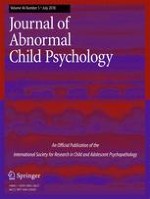10-01-2018
Language Delay and Externalizing Problems in Preschool Age: A Prospective Cohort Study
Gepubliceerd in: Research on Child and Adolescent Psychopathology | Uitgave 5/2018
Log in om toegang te krijgenAbstract
This study sought to examine the direction of causation between language delay and two externalizing problems; inattention and aggression. Autoregressive fixed effects models were fitted to data from 25,474 children (age 1.5 to 5 years; 50.8% boys) in the population-based longitudinal Norwegian Mother and Child Cohort Study (MoBa), to model the direction of causality for language delay and inattention and aggression, respectively. The most parsimonious model for the relationship between language delay and inattention was one where both common factors and reciprocal causation were estimated. Adjusted for common factors, language delay was estimated to have a non-significant effect on inattention by b = 0.12 (p = 0.06), and inattention to have a significant effect on language delay by b = 0.19 (p = 0.03). The most parsimonious model for the direction of causality for language delay and aggression was one where the entire association could be explained by language delay having effect on aggression b = 0.12 (p < 0.02). It appears that while language delay can best be conceptualized as an epiphenomenon of inattention partly related to both common factors and causal processes, aggression can best be conceptualized as caused by language delay. This illumination of the hypothetical causal links between two common problem domains in preschool-aged children has clear implications on where to implement interventions to prevent co-occurrence of language delay and externalizing problems.
